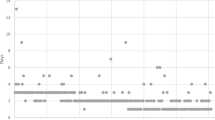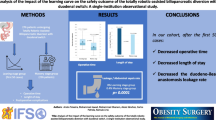Abstract
Background
The biliopancreatic diversion with duodenal switch (BPD/DS) requires operating in three different abdominal quadrants. Previous techniques have used either two docks or a hybrid technique in which the robot is used only to suture the duodeno-ileal anastomosis, while the rest of the operation was performed laparoscopically. Recently, a modification in technique has allowed all operative steps to be completed robotically with a single dock. The operative technique and its technical results are described.
Methods
Operative technique is described. Baseline demographics, operative duration, length of stay, and adverse events (intraoperative, 30-days, and 1-year) of all primary totally robot BPD/DS cases are reported.
Results
From Nov. 2011 to Jan. 2014, 59 totally robotic BPD/DS operations were attempted. One was completed hybrid, and the rest were totally robotic. No robotic operation was converted to an open operation. Five trocars were placed, the small bowel was anchored to the anterior abdominal wall, and the robot was docked. Mean age was 44 ± 10 years with a mean preoperative BMI of 56 ± 9 kg/m2. 69 % was female, and 71 % was Caucasian. Mean operative duration was 306 ± 80 min (60 min less than the hybrid technique). There were no mortality, leaks, venous thromboembolism, or bleeding requiring transfusion. Mean length of stay was 4.6 ± 4.3 days. Three patients were readmitted for nausea and vomiting. There was one superficial wound infection, and three patients needed reoperations in the first year, two for strictures, and one for debriding a suture abscess.
Conclusions
All key technical components of the BPD/DS were performed with low morbidity and mortality with a single dock. Since the surgeon performed all key parts of the operation from the console, the need for experienced bedside assistance was minimized, resulting in shorter operative duration compared to the hybrid technique.




Similar content being viewed by others
References
Flegal KM, Carroll MD, Kit BK, Ogden CL (2012) Prevalence of obesity and trends in the distribution of body mass index among US adults, 1999–2010. JAMA J Am Med Assoc 307(5):491–497
DeMaria EJ, Pate V, Warthen M, Winegar DA (2010) Baseline data from American Society for Metabolic and Bariatric Surgery-designated Bariatric Surgery Centers of Excellence using the Bariatric Outcomes Longitudinal Database. Surg Obes Relat Dis 6(4):347–355
Scopinaro N, Gianetta E, Civalleri D, Bonalumi U, Bachi V (1979) Bilio-pancreatic bypass for obesity: 1. An experimental study in dogs. Br J Surg 66(9):613–617
Hess DS, Hess DW (1998) Biliopancreatic diversion with a duodenal switch. Obes Surg 8(3):267–282
Marceau P, Biron S, Bourque RA, Potvin M, Hould FS, Simard S (1993) Biliopancreatic diversion with a new type of gastrectomy. Obes Surg 3(1):29–35
Marceau P, Hould FS, Simard S, Lebel S, Bourque RA, Potvin M et al (1998) Biliopancreatic diversion with duodenal switch. World J Surg 22(9):947–954
Prachand VN, Davee RT, Alverdy JC (2006) Duodenal switch provides superior weight loss in the super-obese (BMI > or = 50 kg/m2) compared with gastric bypass. Ann Surg 244(4):611–619
Ren CJ, Patterson E, Gagner M (2000) Early results of laparoscopic biliopancreatic diversion with duodenal switch: a case series of 40 consecutive patients. Obes Surg 10(6):514–523 discussion 24
Kim WW, Gagner M, Kini S, Inabnet WB, Quinn T, Herron D et al (2003) Laparoscopic vs. open biliopancreatic diversion with duodenal switch: a comparative study. J Gastrointest Surg 7(4):552–557
Sudan R, Puri V, Sudan D (2007) Robotically assisted biliary pancreatic diversion with a duodenal switch: a new technique. Surg Endosc 21(5):729–733
Biertho L, Lebel S, Marceau S, Hould FS, Lescelleur O, Moustarah F et al (2013) Perioperative complications in a consecutive series of 1000 duodenal switches. Surg Obes Relat Dis 9(1):63–68
Sudan R, Bennett KM, Jacobs DO, Sudan DL (2012) Multifactorial analysis of the learning curve for robot-assisted laparoscopic biliopancreatic diversion with duodenal switch. Ann Surg 255(5):940–945
Feng JJ, Gagner M (2002) Laparoscopic biliopancreatic diversion with duodenal switch. Semin Laparosc Surg 9(2):125–129
Rabkin RA, Rabkin JM, Metcalf B, Lazo M, Rossi M, Lehmanbecker LB (2003) Laparoscopic technique for performing duodenal switch with gastric reduction. Obes Surg 13(2):263–268
Ramos AC, Galvao Neto M, Santana Galvao M, Carlo A, Canseco E, Lima M et al (2007) Simplified laparoscopic duodenal switch. Surg Obes Relat Dis 3(5):565–568
Topart P, Becouarn G, Ritz P (2012) Comparative early outcomes of three laparoscopic bariatric procedures: sleeve gastrectomy, Roux-en-Y gastric bypass, and biliopancreatic diversion with duodenal switch. Surg Obes Relat Dis 8(3):250–254
Baltasar A (2007) Hand-sewn laparoscopic duodenal switch. Surg Obes Relat Dis 3(1):94–96
Buchwald H, Avidor Y, Braunwald E, Jensen MD, Pories W, Fahrbach K et al (2004) Bariatric surgery: a systematic review and meta-analysis. JAMA J Am Med Assoc 292(14):1724–1737
Iannelli A, Schneck AS, Topart P, Carles M, Hebuterne X, Gugenheim J (2013) Laparoscopic sleeve gastrectomy followed by duodenal switch in selected patients versus single-stage duodenal switch for superobesity: case-control study. Surg Obes Relat Dis 9(4):531–538
Sudan R, Kasotakis G, Betof A, Wright A (2010) Sleeve gastrectomy strictures: technique for robotic-assisted strictureplasty. Surg Obes Relat Dis 6(4):434–436
Disclosures
Dr Ranjan Sudan and Dr Erica Podolsky have not disclosures to report.
Author information
Authors and Affiliations
Corresponding author
Rights and permissions
About this article
Cite this article
Sudan, R., Podolsky, E. Totally robot-assisted biliary pancreatic diversion with duodenal switch: single dock technique and technical outcomes. Surg Endosc 29, 55–60 (2015). https://doi.org/10.1007/s00464-014-3653-0
Received:
Accepted:
Published:
Issue Date:
DOI: https://doi.org/10.1007/s00464-014-3653-0




